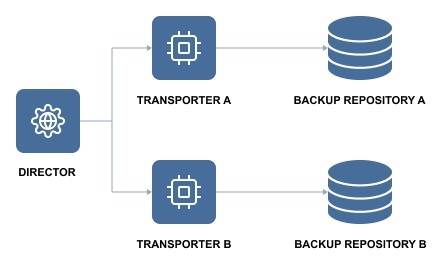Backup Repository
- What is a Backup Repository?
- How Much Data Can Be Stored in a Backup Repository?
- How is a Backup Repository Managed?
What is a Backup Repository?
A Backup Repository is a folder used by NAKIVO Backup & Replication to store backups. When you add a Backup Repository to the product, NAKIVO Backup & Replication creates a folder named “NakivoBackup” in the specified location and keeps all backed up data and Backup Repository metadata in that folder.
Important
- Do not modify or delete any files inside the “NakivoBackup” folder. Modifying or deleting any file inside the “NakivoBackup” folder may irreversibly damage an entire Backup Repository.
- To avoid disrupting NAKIVO Backup & Replication processes and data corruption, add the application to the whitelist/exclusions list of the antivirus software running on the machine on which the NAKIVO Backup Repository is set up.
By default, a Backup Repository is created when the full solution (both Director and Transporter) is installed. The default Backup Repository is named “Onboard repository”.
How Much Data Can Be Stored in a Backup Repository?
The maximum recommended size of a Backup Repository used with NAKIVO Backup & Replication is 128 TB of data after compression and deduplication. For repositories larger than 128 TB, it is recommended to use an Incremental with full backups type of Backup Repository. The number of Backup Repositories per installation is unlimited. Additionally, Backup Repositories can be configured to compress and deduplicate backups at the block level to save storage space.
How is a Backup Repository Managed?
Each Backup Repository is managed by a single Transporter called an Assigned Transporter. In other words, only one Transporter can read data from and write data to a particular Backup Repository.
The Assigned Transporter is responsible for all interaction with its Backup Repository. A single Transporter can be assigned to and manage multiple Backup Repositories.
